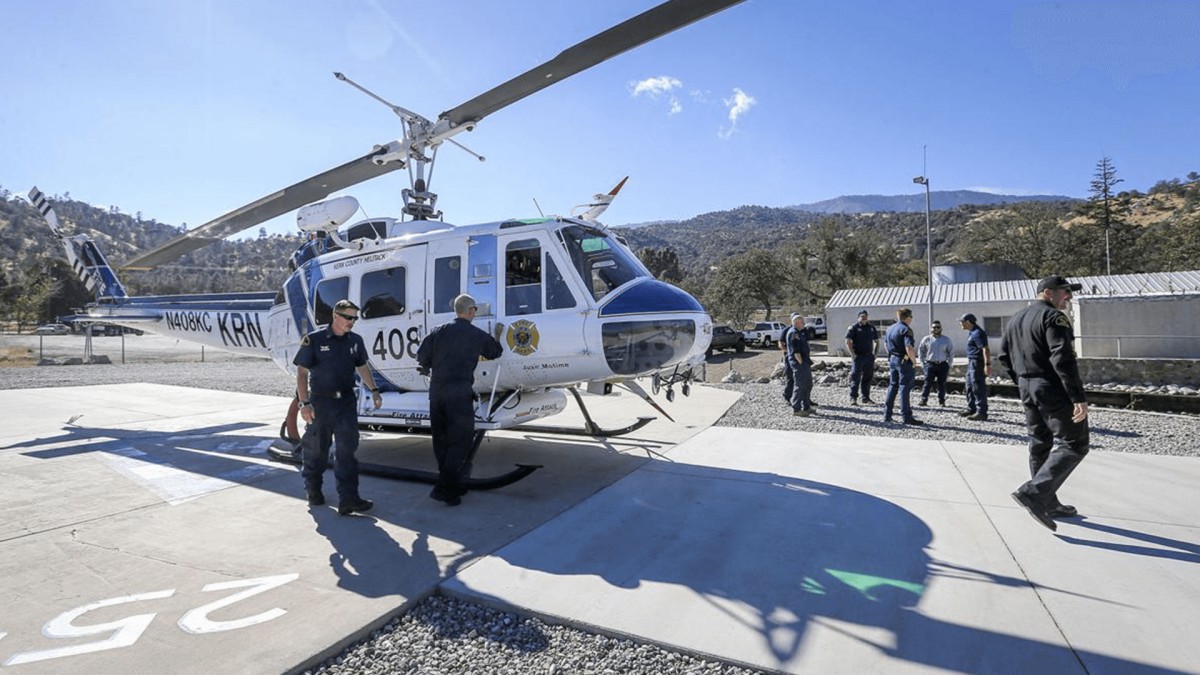Many fire agencies have already embraced NVG technology in their wildfire response management efforts. Check out some examples from California where NVG has made all the difference.
1. Kern County Fire Department
2. Los Angeles Fire Department
3. Orange County Fire Authority
Orange County Fire Authority Night Vision Goggles from TracPlus on Vimeo.
Kern County Fire Department
Kern County Fire Department has been using NVG since 2005, when they received a grant to purchase 5 sets of M4949 ANVIS NVGs. The grant included money for retrofitting cockpit lighting and pilot training from Aviation Specialties Unlimited (ASU) in Boise, Idaho.
Pat Williams, Senior Pilot for Kern County FD wasn’t prepared for the latest in NVG technology. “Both myself and Scott Beck were Army-trained NVG pilots, but hadn’t flown them in about 6 years,” he recalled. “It was an eye opening experience to fly with the new generation of goggles.
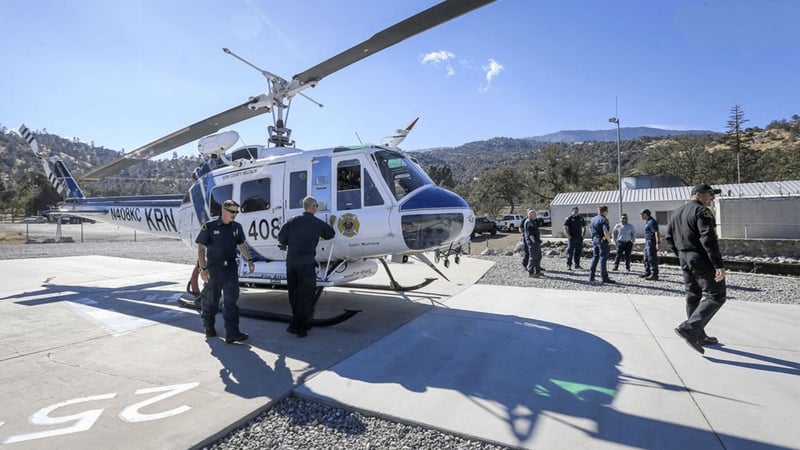
“We were still flying UH-1H’s at that time and we were flying a mix of PVS-5 ‘cutaways’ and ANVIS 6. Cockpits at that time still had a mixture of lighting, so some of the caution panels on the UH-60’s had to be taped over.” Improved filters and circuitry of the M4949’s, however, eliminated many of the limitations of earlier units.
During last year’s Tubbs Fire in Santa Rosa, Kern County FD was able to perform round-the clock operations thanks to double-staffing of their helicopters. “We were operating out of the Healdsburg Helibase, and as the contract ships and CAL FIRE crews were filtering into the helibase for the morning brief, Helicopter 408 was hot refueling and swapping crews to get back out into the fight,” said Williams. “We were proud of the fact that we were the first NVGequipped aircraft to fight fires at night in Northern California.”
But with the switch from daytime operations to nighttime, new hazards arise. “Smoke is almost impossible to see because there is very little reflectance in it,” Williams cautioned. “At night, the first indication of being in a smoke column is that you can’t breathe, and if I can’t breathe then the turbine engine can’t breathe.”
Helicopter support of ground operations is another hazard. “It’s hard to identify personnel on the fireline when making water drops,” agreed Williams. “We’ve found that a couple of red chemsticks on a 3’ string swung rapidly in a circle stand out pretty well, but certain types of LED lights completely disappear under goggles, and as we found out a few years back, LED lights may not show up on other aircraft or vehicles.”
Despite the hazards, however, Kern County FD has pressed forward with training more crews to fight wildfires at night. “We have a mix of ex-military and civilian-trained pilots and I can’t say there is a difference in them,” said Williams. “As always, it comes down to a pilot’s safety practices, and the mission and safety culture a program has. We had the opportunity to participate in the writing of the Firescope Night Flying Guidelines and follow them.”
Williams is definitely sold on flying wildfires at night and encourages others to join. “Tankers, air attack, federal contract helicopters could all benefit from extended attack and night operations,” he asserted. “I do feel that there is a need to limit the use to incidents that meet the night flying criteria specified in the Night Flying Guidelines but as we’ve seen lately, these fires aren’t getting any smaller or less intense.”
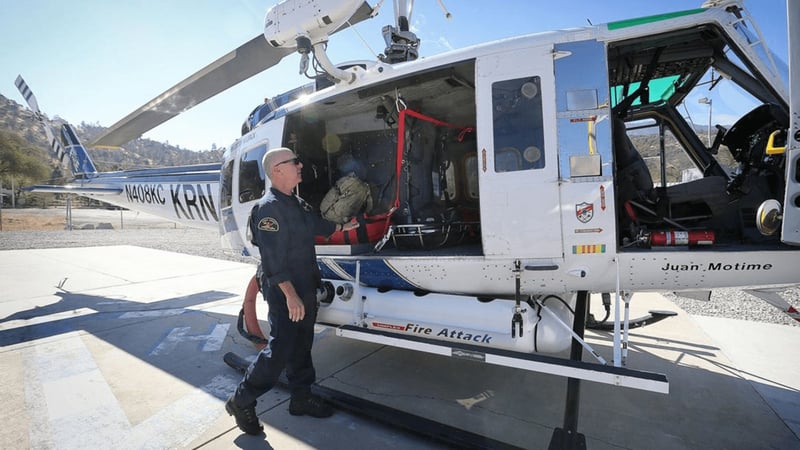
Los Angeles Fire Department
“We’ve been using Night Vision Goggles since 1998,” said Scott Davison, Chief Pilot with Los
Angeles Fire Department (LAFD). “I’ve used them since 2001.”
“The real benefits fighting wildfires is the ability to see hazards, natural or manmade, at night,” he pointed out. But there are also hazards to worry about at night. “The dangers of low-level flight include wires, telephone poles, trees, that sort of thing.”
The brightness of the fire dictates whether LAFD uses goggles or not. “A lot of the wildfires are right there in the wildland-urban interface, so it’s well-lit parts of the city,” said Davison. “Pilots can see if the area is well enough lit with the illumination of the fire and the city lights around the fire.”
But why would a pilot disdain using NVG? Because the total weight of the goggles, the battery pack, the ballast on the helmet adds up to about 7 lbs. But LAFD has come up with a solution for the problem of pilot fatigue. “We fly four-hour rotations where one set of pilots flies for four hours, then we land and do a crew swap,” Davison explained. “Four hours with all that weight on the shoulders and necks can really wear on the crew. If we can safely fly unaided [without NVG] in well-lit areas, we will.”
Another hazard of using NVG at night comes from proximity to the Pacific Ocean. “We have the marine layer come in that you don’t see through the goggles, so you have to look under them,” said Davison. Another trick also helps. “We will have one pilot wearing NVG and another without them on just to balance our awareness of the marine layer as it builds.”
Fighting wildfires at night means also having to reload the helicopter’s water tanks, which poses an additional hazard. “We don’t hover-fill at night, we just ground-fill because any light refracting off moisture in the air will make the goggles halo, bloom or scatter.”
Firescope night-flying guidelines address recommended practices for fighting wildfires at night. Although there are no industry regulations, agencies involved in night flying have their own procedures for certifying pilots on NVG. “We send all of our pilots to Bell Training Academy in Texas,” said Davison. “All of our pilots are flight instructors. Four of our flight instructors are also NVG instructors. We require that all of our pilots fly every 27 days with NVG.”
In addition to having their pilots certified, LAFD’s goggles are inspected every six months at ASU.
Orange County Fire Authority
“We’ve been using NVG for a little over 10 years,” said Karim Slate, Senior Pilot at Orange County Fire Authority (OCFA). “I originally got checked out for NVG by U.S. Forest Service in 1987.”
One of the advantages of using NVG is the ability to zero in on the heart of a wildfire. “Goggles are not like Forward-Looking Infra-Red (FLIR),” said Slate. “But they are very sensitive in the near-infrared, so you can see the hot spots much better at night than you can in the daytime, which makes your drops that much more effective because you’re putting them right where they need to go.”
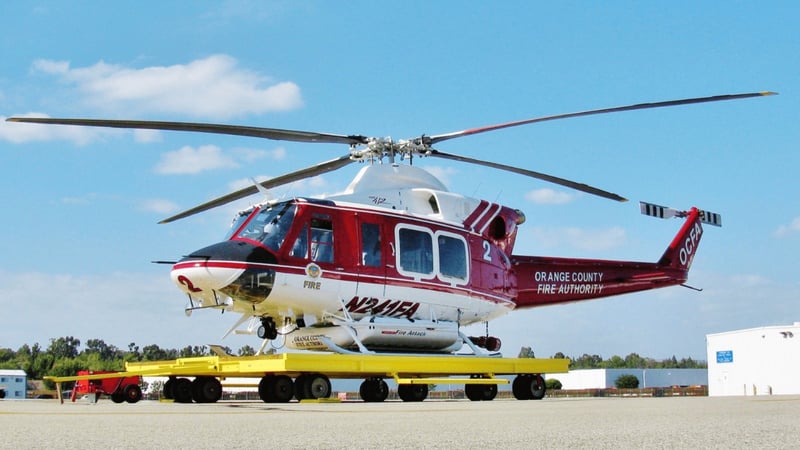
Situational awareness is a critical factor in using NVG. “One of the hazards using goggles is that you are looking through a 40° circle so you don’t have the peripheral vision you have during daytime operations,” Slate explained. “That means you have to be aware of where all the hazards are, including wires and towers. Goggles also allow you to penetrate an obscuration better than you can do during the daytime until suddenly you can’t see through something like a thick column of smoke.”
Although OCFA pilots do snorkel at night, they prefer to ground fill because hovering over water throws up spray which creates what the Coast Guard calls a ‘milk bowl effect’ from the lights refracting off the spray in such a way that it disorients the pilot.
Outfitting a helicopter to make it NVG-capable can be costly. “About the cheapest you could retrofit a Type 2 helicopter cockpit for NVG would be between $50,000 and $100,000,” Slate asserted.
Pilots, even ex-military pilots with hundreds of hours of NVG flight time, still aren’t fully prepared for fighting wildfires at night, as Slate explained. “Firescope night-flying guidelines
state that a pilot cannot get carded to fight fires at night with NVG without at least 50 hours of goggle experience in that environment. The pilot also has to have experience fighting wildfires in the daytime.”
As with many other types of aviation, there are checklists to make sure pilots can safely operate before going on a night mission. “The Firescope guidelines’ Go/No-Go checklist asks whether the threat is high enough to justify the added risk and whether the conditions are suitable. You can’t be effective flying around in extremely low visibility at night. We use a Flight Risk Assessment Tool (FRAT) to determine whether it’s safe to fly.”
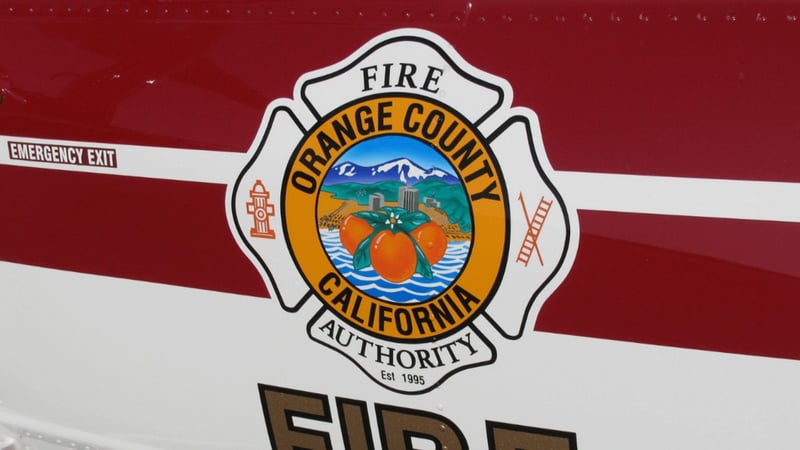
Despite the hazards, expense, and training time required, however, Slate feels it is a worthwhile investment for any fire agency and foresees other agencies joining the club in the future. “I would recommend NVG to other departments and agencies because of its effectiveness when properly utilized. Southern California is the only place that has turned NVG operations into a fine art. In the next few years, when CAL FIRE gets its Black Hawks, they’re going to be getting into it as well.”
Find out more about how NVG are being introduced throughout Australasia.
